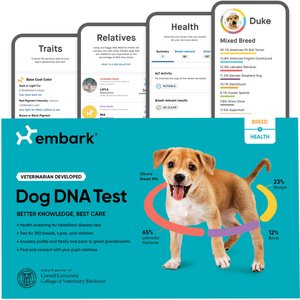I have a purebred dog and three mixed-breed dogs, including a recently adopted one-year-old from a shelter in Slovakia. My dogs come from all over the world. I’ve moved a lot and ended up adopting a dog in every country I’ve lived in for the past 10 years. My older dogs look like a little bit of everything, but my new pup definitely has some terrier in him, so I started to wonder: what breed is he, exactly, and does it really matter?
I started researching to see what my options were. Turns out, there are several dog DNA tests, with kits ranging in price anywhere from $60 to $200. The cheaper tests don’t have a large database of breeds available (these tests test for about 84 breeds out of the 187 recognized by the American Kennel Club), which means you might not get a complete family tree.
I finally settled on an Embark DNA test for a number of reasons, including the fact that Embark does charitable work with animal shelters and that the company partnered with Cornell University College of Veterinary Medicine to ensure cutting-edge technology and accuracy in testing.

I also decided that, in addition to testing Jimi (my Slovakian maybe-terrier pup), I would also test Rek, the dog I rescued from the streets while living in Thailand. Embark has something called “village dog” in their breed database, and that piqued my interest because Rek doesn’t resemble any breed. According to the Embark website, “village dogs are the free-breeding, free-roaming ‘outside’ dogs found around the world …. [they] descend from separate lines of dogs than the lines that have been bred into standardized breeds like Labradors and Poodles.” In essence, they are almost their own breed – and that alone deserved a test.
The DNA-Testing Process
Once I got the two DNA-testing kits and read all the information, it was time to take a sample. The idea is simple: use the giant swab provided to collect saliva from your dog. I caught Jimi when he was just waking up from a nap, so I don’t think he had time to figure out what was inside his mouth and what exactly was going on before I got his sample. Rek wasn’t as keen to participate in the experiment and gave me a couple of death stares while I was trying to collect her saliva.
With the saliva sample collected, you lock the swab inside the provided tube, then shake it to allow it to mix with a special liquid, which protects the DNA until it reaches the lab. Since I live in Europe, the next step was a trip to FedEx and a very interesting conversation with the guy at the counter about shipping dog saliva across the ocean. Apparently, US customs is not very excited about the idea of dealing with liquids in little tubes, so we settled for a custom form that read “dog testing kit” and hoped for the best.
The tests made it through.
Some Breed Surprises (And Some Not)
It generally takes between six and eight weeks for test results to come back, but the company sped up my dogs’ results so that I could have them on time for this piece (it took just over four weeks). Results of the test are available online through the Embark website. You have to create an account when you first receive the tests, then, once the results are ready, they are added under each dog’s profile. The company also has an app you can download to access the results.
Rek’s breed came back as “100 percent Southeast Asian village dog.” I hadn’t told the lab where she was originally from (Southeast Asia), so the DNA test was exact enough to distinguish among village dogs from different continents. In fact, her DNA results came with a map that showed the countries where she most likely came from. A rather impressive match.

Of course, it’s also slightly disappointing. “Village dog” says very little about who Rek is and what her ancestors looked like, although Embark did tell me that Rek is part of the C2 Haplogroup, which “is a very old female lineage [that can] be traced back to where dogs and people first became friends.”
Rek also had a unique result in the “wolfiness score.” Embark tests dogs for genes that indicate the presence of wild genetic markers that have survived for centuries. According to Embark, most domestic dogs have “wolfiness scores” of under one percent (Jimi’s was 0.3 percent) but Rek’s was marked “HIGH” at 4.3 percent. Perhaps a reminder of her primitive roots.
Jimi’s lineage was a little more surprising. I was expecting some terrier and possibly some Schnauzer in him, since he sports a (very adorable) beard, and he is a little bit of both. But the test also said that he’s 35 percent German Shepherd, which I didn’t in any way expect. Though it might explain his pointy ears and slightly larger size compared to terriers, there’s not much else visually that tells me Jimi is part shepherd of any kind. I probably wouldn’t have guessed that much Maltese either (which came back at 18 percent), although he has a permanent smile on his face, so that could’ve been a clue.
Jimi is also partially a “supermutt,” a cute term created by Embark to indicate a mix of other breeds that are present in only tiny amounts so they can’t be accurately identified.
While the surprise breeds seemed so unlikely to me, the report does go into very detailed explanations of genes that make Jimi look the way he does: his hair color (almost completely white with some slight tan undertones), how much he sheds (he’s primarily German Shepherd when it comes to shedding) and even body size – and it all makes sense if you actually take the time to read the very detailed data. In fact, the test accurately “guessed” both Jimi’s and Rek’s weight and genetic age.
Using DNA Tests to Predict Health
Embark is also the only DNA testing company that currently tests for 160 different genetic issues in addition to checking breed. The genetic section of the test is extensive, and I’d never heard about some of the conditions they test for, so I emailed Ryan Boyko, the founder and CEO of Embark Veterinary, and asked how many of the conditions tested for are rather common in dogs.

“A few common conditions our screening can help catch early include multiple drug sensitivity, kidney and bladder stones, adult-onset blindness caused by progressive retinal atrophy, heart disease caused by DCM (dilated cardiomopathy), glaucoma, degenerative myopathy or Lou Gehrig’s disease, and gastrointestinal intolerance,” Boyko said in his reply. “We also test for health traits like liver enzyme levels which can improve a veterinarian’s ability to care for every dog.”
I was curious about Rek carrying any genetic issues related to gastrointestinal conditions, since she seems to have occasional intestinal and digestion problems, but both dogs were clear of every possible health issue the test checks for (and perhaps Rek’s issues are more a result of the year and a half she spent living on the streets before I found her, eating whatever she could find).
Was the test worth it? Definitely. Aside from learning really interesting data, I now understand my dogs a little better. Rek’s high “wolfiness” percentage and more primitive origins explain why she’s an independent, sometimes elusive dog. Jimi’s genes tell me the courageous, super-bouncy dog with guard tendencies I adopted needs a social active environment to thrive – something I intend to give him as much as I can.

Diana Bocco is a full-time writer and adventurer, whose work has been published in DiscoveryChannel.com, Yahoo!, & Popular Mechanics.
Share:









